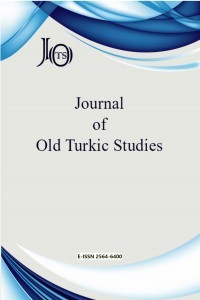Hun Siyasî Sisteminde Akrabalık
This paper aims to examine the social bases of the hierarchical political organization based on kinship, which is typical with the Xiongnu (Asian Hun) and their successors, and the basic concepts that express it in the context of the cultural continuum. The study also analyzes the role of kinship diplomacy within the political culture of Xiongnu with historical instances and concludes that despite some exceptions, Xiongnu had developed an institutionalized political hierarchy based on kinship relations.
Anahtar Kelimeler:
Xiongnu, Asian Huns, kinship, kinship diplomacy, political system
Kinship in the Xiongnu Political System
This paper aims to examine the social bases of the hierarchical political organization based on kinship, which is typical with the Xiongnu (Asian Hun) and their successors, and the basic concepts that express it in the context of the cultural continuum. The study also analyzes the role of kinship diplomacy within the political culture of Xiongnu with historical instances and concludes that despite some exceptions, Xiongnu had developed an institutionalized political hierarchy based on kinship relations.
Keywords:
Xiongnu, Asian Huns, kinship, kinship diplomacy, political system,
___
- Ban, Gu 班固. (1962). 漢書 [Han Kitabı]. Beijing: Zhonghua shuju.
- Birge, B. (1995). Levirate Marriage and the Revival of Widow Chastity in Yüan China. Asia Major, 8(2), 107-146.
- Broadbridge, A. F. (2018). Women and the Making of the Mongol Empire. Cambridge: Cambridge University Press.
- Clauson, Sir G. (1972). An Etymological Dictionary of Pre-Thirteenth Century Turkish. Oxford: Oxford University Press.
- Durrant, S. et al. (2016). Zuo Tradition/Zuozhuan: Commentary on the “Spring and Autumn Annals”. Seattle & London: University of Washington Press.
- Dziebel, G. V. (2007). The Genius of Kinship: The Phenomenon of Human Kinship and the Global Diversity of Kinship Terminologies. New York: Cambria Press.
- Ecsedy, H. (1972). Tribe and Tribal Society in the 6th Century Turk Empire. Acta Orientalia Academiae Scientiarum Hungaricae, 25, 245–262.
- Erkoç, H. İ. (2016). Batı Göktürk Kağanlığı'nın Kuruluşu. Hacettepe Üniversitesi Edebiyat Fakültesi Dergisi, 33(1), 43-72.
- Erkoç, H. İ. (2019). Göktürk Boylarının Tespit Edilmesinde Çin ve Tibet Kaynaklarının Önemi. Alpargu, M. et al. (Eds.), Genel Türk Tarihi Kaynakları: Ordu Çalıştayı Bildirileri (pp. 77-160). Ordu: Kültür Yayınları.
- Fan, Ye 范曄. (1973). 後漢書 [Sonraki Han Kitabı]. Beijing: Zhonghua shuju.
- Fang, Xuanling 房玄齡. (1974). 晉書 [Jin Kitabı]. Beijing: Zhonghua shuju.
- Harmatta, J. (1952). The Dissolution of the Hun Empire. Acta Archaeologica, 2(4), 277-304.
- Hazanov, A. M. (1975). Sotsial’naya istoriya skifov. Moskva: Nauka.
- İnalcık, H. (1959). Osmanlılar’da Saltanat Veraseti Usulü ve Türk Hâkimiyet Telakkisiyle İlgili. Ankara Üniversitesi SBF Dergisi, 14(1), 69-94.
- Kim, H. J. (2017). The political organization of Steppe empires and their contribution to Eurasian interconnectivity: the case of the Huns and their impact on the Frankish West. Kim, H. J. et al. (Eds.), Eurasian Empires in Antiquity and the Early Middle Ages Contact and Exchange between the Graeco-Roman World, Inner Asia and China içinde (pp. 15-33). Cambridge: Cambridge University Press.
- Kradin, N. N. (2011). Stateless Empire: The Structure of the Xiongnu Nomadic Super-Complex Chiefdom. Brosseder, U. & Miller, B. K. (Eds.), Xiongnu Archaeology: Multidisciplinary Perspectives of the First Steppe Empire in Inner Asia içinde (pp. 77-96). Bonn: Vor- und Frühgeschichtliche Archäologie, Rheinische Friedrich-Wilhelms-Universität Bonn.
- Lessing, F. D. (1960). Mongolian-English Dictionary. Bloomington-Indiana: The Mongolia Society.
- Liao, Yang 廖杨. (2004). 匈奴宗法文化论 [Xiongnuların Ataerkil Kültürü Üzerine]. Journal of Inner Mongolia University (Humanities and Social Sciences), 36(1), 17-20.
- Lin, Gan 林幹. (1986). 匈奴通史 [Xiongnu Genel Tarihi]. Beijing: Renmin chuban she.
- Lindholm, C. (1986). Kinship Structure and Political Authority: The Middle East and Central Asia. Comparative Studies in Society and History, 28(2), 334-355.
- Linghu, Defen 令狐 德棻. (1971). 周書 [Zhou Kitabı]. Beijing: Zhonghua shuju.
- Liu, Xu 劉昫. (1975). 舊唐書 [Eski Tang Kitabı]. Beijing: Zhonghua shuju.
- Lkhagvasuren, G. vd. (2016). Molecular Genealogy of a Mongol Queen’s Family and Her Possible Kinship with Genghis Khan. PLOS ONE, 11, 1-31.
- Mary, L. vd. (2019). Genetic Kinship and Admixture in Iron Age Scytho-Siberians. Human Genetics, 138(4), 411-423.
- Miller, B. K. (2014). Hun “Kings” and the Political Order of the Steppe Empire. Journal of the Economic and Social History of the Orient, 57(1), 1-43.
- Onon, U. (2001). The Secret History of the Mongols: The Life and Times of Chinggis Khan. London, New York: Routledge.
- Ouyang, Xiu 歐陽修. (1975). 新唐書 [Yeni Tang Kitabı] Beijing: Zhonghua shuju.
- Ögel, B. (1982). Türklerde Devlet Anlayışı (13. Yüzyılın Sonlarına Kadar). Ankara: Başbakanlık Basımevi.
- Scheffler, H. W. (1980). Kalmuk Mongol Kin Classification. Anthropological Linguistics, 22(6), 233-247.
- Sima, Qian 司馬遷. (2014). 史記 [Tarihçinin Kayıtları]. Beijing: Zhonghua shuju.
- Taskin, V. S. (1973). Materialy po istorii syunnu (po kitayskim istoçnikam). Vvedeniye, perevod i kommentarii V. S. Taskina (2). Moskva: Nauka.
- Taşağıl, A. (2003). Göktürkler I. Ankara: Türk Tarih Kurumu.
- Taşbaş, E. (2019). The Turkic Kinship System. Acta Orientalia Academiae Scientiarum Hungaricae, 72(2), 245-258.
- Tekin, T. (1998). Orhon Yazıtları: Kül Tigin, Bilge Kağan, Tunyukuk. İstanbul: Simurg.
- Tishin, V. V. (2019). A Study of the Ancient Turks Family. Social Evolution & History, 18(2), 115-132.
- Xie, Jian 謝劍. (1969). 匈奴社會組織的初步研究 (氏族、婚姻、和家族的分析) [Xiongnu Sosyal Organizasyonu Üzerine Ön Çalışma (Soy, Evlilik ve Aile Analizi)]. Bulletin of the Institute of History and Philology, Academia Sinica, 40, 669-720.
- Yayın Aralığı: Yılda 2 Sayı
- Başlangıç: 2017
- Yayıncı: Erdem UÇAR
Sayıdaki Diğer Makaleler
Dede Korkut’un Yeni Kolaj Tarzı Yazması Hocali Molla’nın mıdır?
Dağlık Altay Yazıtlarından Kuray I (A 4) Üzerinde Yeni Bir Okuma ve Anlamlandırma
A Hunnic Word for Spoon: 留犁 Liuli
Dede Korkut’taki Demir Gücü Üzerine Bir Değerlendirme
Dede Korkut Kitabı’nın Dresden Yazmasında Geçen “Boy(u)n[ıy]ıla Kulag[ın] Almak” Deyimi Üzerine
